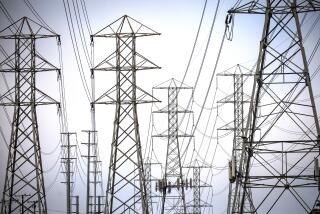Repairs, Energy Costs Send Water Rates Spurting
- Share via
With energy costs up and systems wearing down from age, about one-third of Orange County’s 31 water districts are increasing their rates, and many others face potential rate increases when their budgets are approved in June.
Water officials say the increases are necessary to maintain water quality and assure uninterrupted service.
Most increases are slight, just a few dollars a month at most for consumers. But looming is an issue liable to affect water customers throughout the county: Over the next 12 years, California will be forced to reduce the amount of water it gets from the Colorado River because of increased demand in Nevada and Arizona.
“No one has the answer,” said Patrick Scanlon, general manager of the Southern California Water Co., which serves part of northwest Orange County. “That’s why it’s more important than ever that people use water efficiently and not waste it.”
The Colorado is one of Orange County’s two major sources of imported water. The other is Northern California aqueducts. Imported water costs about four times as much as local ground water.
The Metropolitan Water District of Southern California, the wholesaler that oversees water imported into Orange County, considers the Colorado River situation controllable.
“We haven’t had a rate increase in five years and we don’t foresee one for next year,” said chief financial officer Brian Thomas. “When we are forced to increase rates, we believe they will be reasonable and manageable.”
A more immediate concern is the rising price of energy. In the El Toro Water District, for example, the energy cost to keep its well pumping jumped this year from $800,000 to $1.2 million, a 50% increase. The district managed to avoid passing on that increased cost to customers because it produced income from its storage reservoir and from leasing equipment for clearing out pipe systems. But general manager Bob Hill said future rate increases are almost a certainty if energy costs continue to rise.
In Laguna Beach, water rates went up 7% in June--although the original plan called for a 14% increase, said Laguna Beach Water District spokeswoman Renae Hinchey. “But we went through our budget as thoroughly as we could and just kept cutting and cutting, trying to keep the increase down,” she said.
The Yorba Linda Water District has ordered increases for both 2002 and 2003 that will bring the rate up almost 20%. The current charge is $1.03 per billing unit (100 cubic feet of water). Next summer, that goes up to $1.13, and to $1.23 the summer after that. District spokesman Mike Robinson pointed out that the water district still will have among the lower prices in the county.
Laguna Beach and the Santiago County Water District charge the most in the county, $2.50 per billing unit, because a high percentage of their water is imported.
Another factor in rising prices is the replacement of worn-out equipment.
Thousands of feet of water lines were installed in the 1960s, when the county’s population began to boom. But those cast-iron pipes were not built to last more than about 35 years, said Steve Smith, water manager for Orange.
His city has had to increase prices by 9%, partially because of the cost of replacing pipes. But Smith pointed out it’s the first increase city residents have faced in seven years.
The South Coast Water District has an ongoing program to replace pipes, some of which are 80 years old, said spokeswoman Linda Homeschied. The district is increasing its rates this fiscal year by 14%, but she pointed out that this is the first increase in eight years.
More to Read
Sign up for Essential California
The most important California stories and recommendations in your inbox every morning.
You may occasionally receive promotional content from the Los Angeles Times.













